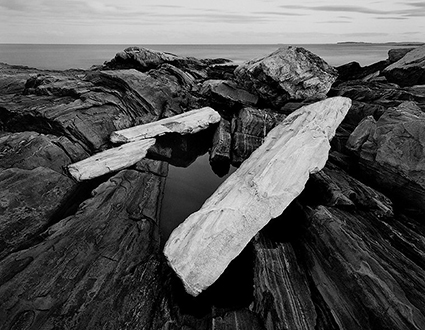 .
.
John Sexton
View 12 Great Photographs by John Sexton
Read the extended conversation.
John Sexton was born in 1953, and has lived on the Monterey Peninsula in California for more than thirty years. Respected as a photographer, master printmaker, author, and workshop instructor, he is best known for his luminous, quiet, black and white photographs of the natural environment.
John’s most recent book is Recollections: Three Decades of Photographs, an award-winning retrospective volume, published in late 2006 by Ventana Editions. John’s previous award-winning books include Quiet Light a monograph representing fifteen years of his work, and Listen to the Trees, which were published by Bulfinch Press/Little, Brown and Company, along with Places of Power: The Aesthetics of Technology published by Ventana Editions.
He is Director of the John Sexton Photography Workshops program, and teaches numerous photography workshops each year for other programs in the United States and abroad, emphasizing printing technique and mastery of the Zone System. Some of these other programs include: Anderson Ranch Arts Center, The Ansel Adams Gallery, Maine Photographic Workshops, and The Palm Beach Workshops.
What’s the best thing about photography?
The ability to create an abstract, but believable, representation of the subject in front of the camera, along with a personal interpretation by what is behind the camera – the photographer.
What’s the worst thing about photography?
People seem to think when they buy a camera they instantly become a photographer.
What’s the thing that interests you most about photography?
Discovering the magic of light and how it can reveal and obscure subjects, ideas, and concepts.
What’s the thing that interests you most about your own photographs?
Looking at my own photographs gives me an opportunity to see how my vision changes over time, as well as how I change as a person.
What’s the thing that interests you most about other people’s photographs?
Other people’s photographs give me the opportunity to see through their eyes, and discover things I would likely have never seen myself.
Who were your early photographic influences?
Above all others it was Ansel Adams, along with Wynn Bullock, Paul Caponigro, Brett Weston, Ruth Bernhard, Henry Gilpin, as well as my photography instructors Olaf Lee and David Drake.
Who are your photographic influences now?
My influences today include many photographer friends, colleagues, and students whose work continues to inspire and amaze me.
Who were your early non-photographic influences?
John Muir, Edward Abbey, and Georgia O’Keeffe
Who are your non-photographic influences now?
Planet Earth.
What’s the most inspiring work of art you saw recently?
A magnificently constructed spider web.
What’s the best thing about gear?
Provides tools that can be useful.
What’s the worst thing about gear?
The misconception that photographic gear, in and of itself, can lead to better photographs.
How do you know when an image doesn’t work?
I know an image is not successful for me when, after a period of time, it does seem to produce any sort of what I call a “magic quotient.”
How do you know when an image is good?
I know an image is good for me when I find myself wanting to look at it again and again.
How do you know when an image is great?
I know an image is great for me when I can’t get it out of my mind.
What’s the most useful photographic mantra?
Photographs are illusions.
Do you practice another art form? (If so, which?)
Music… during an earlier lifetime.
What benefits do you get from (this/these) other art form/s?
The ability to lose oneself.
What was the most significant visual moment in your life?
Attending an exhibition of photographs at the Pasadena Museum of Modern Art (today the Norton Simon Museum) by Ansel Adams, Edward Weston, and Wynn Bullock as part of a college photography class field trip.
Which was the most important image to you that got away?
A landscape image of Grand Gulch, near the San Juan River in Utah.
What failure did you learn the most from?
Not realizing early enough that mistakes and failures are the best learning experiences.
What accomplishment are you most proud of?
The opportunity to work with so many dedicated students over the years.
What’s the thing you most hope to accomplish?
To continue to be excited and passionate about life and photography.
If you had to do it all over again, what would you change?
If I could do it all over again, I would like to be able to spend ALL of my time doing photography, and try and do as little as possible in terms of the business, promotion, paperwork, etc. that comes along with life.
If you had another life to live a completely different life, what would you choose to do?
Professional drag racer.
What are the most important questions to you?
The most important question to me is… why?
How did photography change your world?
Photography caused me to look at the world in a different way. I think I sometimes miss the big picture, but I enjoy experiencing the mosaic of many details.
What’s the worst thing about influence?
It’s easy to inadvertently find yourself walking in another’s footsteps.
What’s the best thing about our times?
Life!
What’s the worst thing about our times?
Hatred.
What’s your favorite movie?
“Being There”
What’s your favorite book?
“Desert Solitaire” by Edward Abbey
What’s your favorite piece of music?
“Canon in D” by Johann Pachelbel
What is the trait you most deplore in yourself?
Procrastination.
What is the trait you most deplore in others?
Arrogance.
What’s your motto?
Learn from the mistakes of others. You don’t have time to make them all yourself.

